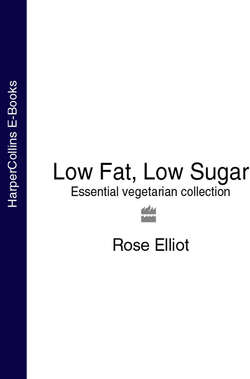Читать книгу Low Fat, Low Sugar: Essential vegetarian collection - Rose Elliot - Страница 8
Оглавлениеequipment and techniques
The only special equipment needed for low-fat, low-sugar cooking is one or two non-stick pans: ideally, a large non-stick frying pan with a lid and a medium-sized saucepan for making sauces and other mixtures that tend to stick. A non-stick baking sheet or tray is also useful or, alternatively, you could buy some of the non-stick fabric which you simply place on an ordinary baking tray. It can be washed and re-used time and again.
DRY-FRYING
The recipes in this book are fairly simple and do not involve complicated techniques. However, what I call ‘dry-frying’ is used in quite a number of the dishes. This is simply cooking in a frying pan or saucepan (non-stick) without added oil or liquid. By dry-frying an onion, for instance, you can get a result very much like fried onion. Put a fairly finely chopped onion into the frying pan, cover with a lid and set over a gentle heat. Let it cook for 6–7 minutes, stirring often. It will soften and become lightly flecked with brown. Turn up the heat if you want to brown it more, but take care because it’s easy to burn it and get a bitter flavour. If this seems likely, add a little water or stock and continue to gently ‘fry’ the onion until the liquid has disappeared and the onion is tender.
You can use this technique with any vegetable if you want a fried effect without using fat. If using no fat seems too extreme, you could try using just a teaspoonful of olive oil. It’s surprising how little you need. When I started experimenting with recipes for this book I initially used a teaspoonful of oil for the frying process, but having tried frying onions without any oil, decided to opt for this ‘purer’ approach which seemed to give results which were just as good. Once you start using little bits of oil here and little bits there, it starts to add up and the diet stops being ‘low fat’. However, how low you go is up to you; because the recipes are strict you have the scope to add a little fat here and there where it matters to you. One tablespoonful of oil adds 15 grams of fat to a recipe; a teaspoonful adds 5 grams of fat.
THE OIL AND WATER SPRAY
I think the idea for this originally came from low-fat cook extraordinaire Sue Kreitzman. All you do is buy a small spray bottle at a chemist or garden centre, fill this with olive oil and water in the proportion of 1 part oil to 8 or 10 parts water, shake well, then spray over your food. I use this on Mediterranean vegetables such as aubergines (eggplants) and courgettes (zucchini), or on burgers and rissoles before grilling or baking them. An alternative would be to use one of the oil sprays which you can buy in supermarkets, but making your own is so easy and you know exactly what’s in it. The only time when a supermarket oil spray is useful is for greasing cake tins (pans), although if you use non-stick baking parchment you don’t need it.
